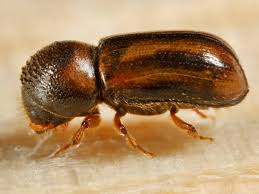Ambrosia beetle:

Rubber plantations in Kerala have been under threat since an ambrosia beetle-fungus alliance has been attacking trees, causing severe leaf fall and rapid drying.
- Ambrosia beetles get their name from the ambrosia fungi that call the beetle their home. The name ‘ambrosia’ is not taxonomic but ecological.
- These beetles are native to Central and South America.
- They were first reportedin India in the cashew trees of Ponda, Goa, in 2012.
- The beetle has been reported to share a mutualistic relationship with two fungal species, Fusarium ambrosia and Fusarium solani.
- These beetles attack dead or infected trees, although they’re also known to attack stressed trees.
- At times, the stressed trees release ethanol, a volatile compound that the ambrosia beetles can sense and attack.
- The beetles don’t feed on the woody bark of trees; the fungi do.
- The beetles bore tunnels called galleries in the bark, carry fungi into the galleries, and farm the fungi to concentrate nutrients.
- The beetles and their larvae feed on nutrient-rich fungal mycelia. The fungi also release enzymes that weaken the wood, allowing beetles to penetrate deeper.




